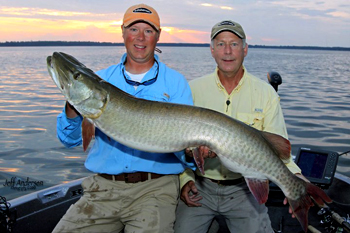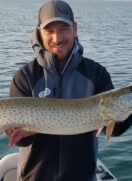“Muskies made easy!” If you ever heard those words come out of any angler’s yapper, he is leading you out to sea. Truthfully, there is nothing easy about consistently catching the freshwater king. And coming from a guide who fishes them and whose business is selling the chance to wrestle one into the boat, you can be sure I’m telling you the truth when I say that it’s not easy putting your mitts on a successful catch!
But why, you might wonder, would a guide who makes his living selling trips tell prospective clients that there is nothing easy about catching muskies? Because, while it may not be simple, it’s certainly not impossible; and, because, most important of all, there are several variables you can do to increase your odds at catching the fish of a lifetime.
From the first cast to the last the prospect that, maybe, just maybe on this next cast, you might hook into a monster that makes all of the doubts, difficulties, maybes, and next-times worth it!
Leisure Outdoor Guide Jeff Anderson with a nice MuskieTime of Year
To begin with, understanding seasonal “bites” is a key element to upping your odds, especially when it comes to fishing for early-season muskies. In Minnesota, Musky Opener is June 2nd, and in Canada it varies with your location though it is typically closer to the end of June. Muskies are one of the last fish to spawn which starts when the water temps reach 49 to 59 degrees, and thus the later opening helps protect the resource.
Spring fishing means the muskies are fresh and haven’t been fished for several months. Still, if you have ever been out and about during the early season when there is, according to this logic, an abundance of fish, you have probably asked yourself where in the heck are they?
After the spawn, the females dump off into deeper basins adjacent to spawning sites. Depending on the various temperatures in a given spring season and depending on water temps, there are two locations on which to focus your efforts. First, you can target the larger female fish out over open water, or secondly, you can narrow in on fresh green cabbage closest to spawning grounds. I spend several days prior to musky opener looking for green cabbage with polarized sunglasses. It’s truly amazing what I have learned by spending hours upon hours studying how the weeds grow.
Additionally, you might also want to focus on shallow, warm-water areas -- especially during unusually cold springs. These latter areas include warm-water creeks, sandy bays, and shorelines hit by the sun throughout the day.
Presentation
My favorite early-season musky bait is the Storm Giant Flat Stick. Why? Twitch-style baits are by far the most versatile lure in a musky fisherman’s tackle box. While fishing the fresh green weeds, the main triggering quality involves making constant contact with the tops. With a hard twitch, the bait will snap through the weeds. In this situation, keeping a clean lure, followed by a pause is a recipe for a musky attack.
I also use the Giant Flat Stick over the open water location. One of my favorite approaches is to position my boat on the shallow edge and casting deep. This technique gives me the opportunity to contact those fish that are out off the structure as well the fish outside weed edge. The nice thing is that if I don’t contact fish in this fashion, I can then easily transition farther away from the break.
If I’m stilling searching for fish after trying these spots and tactics, I will look to the shallow-sight fishing bite. If you locate fish shallow, you can be in for one of the most intense bites, as everything happens right in front of you. In this situation, the importance of a pair of quality-polarized sunglasses can’t be overstated.
The search begins and with my Minn Kota Terrova teamed up with the iPilot. Once I locate a fish, I will hit spot lock, which keeps me in place without me having to touch another thing. This means I can focus on my presentation and not worry about controlling my bow mount.
There are a variety of lures including jigs and smaller soft plastic I utilize in this situation. The key is, regardless of which one you select, to cast beyond the fish and bring the lure into the strike zone. Then, be sure to read how the musky reacts to different presentations. Sometimes it’s best to let the fish see the bait, when it reacts to the bait, let it lay there. If the fish doesn’t take the bait I will then walk the lure along the floor of the lake. This imitates bait trying to escape by digging themself into the sand.
A happy Leisure Outdoor Adventures customer after a 55" muskie with guide Jeff AndersonMake a not-so easy fish easier
Like many other muskie fisherman who have enjoyed some success and even more failure, I have experienced carpel tunnel, blisters, sore muscles and everything in between when logging long hours; so, here then are a few things to help make your efforts easier and, hopefully, to make it more likely they will result in less carpel tunnel and more monster muskies.
Matching your fishing rod to your presentation
Most of the musky rods today are built for the lure you throw, rather than for the actual fight. The reality is you can land a huge fish on a wimpy rod but can’t handle the demands of casting huge musky lures throughout the day. I prefer the Jason Mitchell Elite Series Musky Rods, a competitively priced rod built to handle the demands of musky fishing. In the Elite Series line up are all sizes of rods to fit each need; but if you are looking for an all-around perfect, do-all size, the 8-footer fits most needs. However, I have personally used the brand new 9-footer for the last season, and I’m very excited about it. Here’s why—
A typical musky day includes hundreds, if not thousands, of casts. The long rod requires less effort and longer casts. It also means that for each figure 8 at the boat side, you can expect wider turns and you don’t have to bend over as far. See where I’m going? Less effort means that when you are in the 10th hour of casting your focus won’t be on your sore back but on that bite that is, one can hope, bound to happen.
Utilizing lures that don’t put so much strain
I think you can see the common thread that sometimes musky fishing is all about putting the work in, being efficient and making more casts than the next guys. Yes an efficiency game, which involves an economy of scale! Most musky fisherman, even with the best equipment, become worn down and worn out by the demands of casting monster lures all day; so, in order that you can stay in the game and, eventually, turn the odds in your favor, don’t hesitate to downsize your bait. This keeps you in the game!
Sore Backs and Slimy Hands with Big Rewards
There are many superb days when my clients catch their first musky in the first hour or two of casting, and, as you might imagine, there are also those equally pleasant but somewhat frustrating outings when hours pass without a hit and I become the motivating coach saying, “Keep it going guys!” To be sure, the fisherman driven by the appeal of the often elusive freshwater king and the thought of holding up first the fish and later the photo most likely to succeed are those who heed the above-tips and techniques and, most importantly, keep casting. These are ones who will be rewarded with those slimy hands at the end of the day.
“Make a Memory and Get Hooked”
Jeff “Breezer” Andersen





